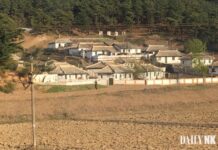Unification Media Group (UMG): It’s become extremely cold across the Korean peninsula, with temperatures plummeting well below zero and snow falling in many provinces. Coffee and tea shops in South Korea are bustling with clientele seeking an escape from the cold, but today we’re going to hear about how tea culture is spreading in the North as well. Special correspondent Kang Mi Jin is here to tell us more.
So what kinds of tea do North Koreans typically drink?
Kang Mi Jin (Kang): Tea drinking is a relatively new culture in North Korea, which I heard about from a source living near the border in North Korea last weekend. She told me that she bought tea from China last year, but this year, she has grown a preference for making her own ginger tea. This trend of people drinking homemade tea seems to be on the rise. Because a lot of people need to attend end-of-year events and loyalty training sessions these days, a tea break affords them the opportunity to just stop and relax for a moment.
UMG: It seems that North Korean border towns would be more susceptible to the influence of Chinese culture right across the border. China’s historical love of tea culture also comes to mind in this case.
Yes, North Korea is by no means unfamiliar with tea given their proximity to China, and people in Pyongyang, Hamhung, and other large cities are well-accustomed to it. But in areas outside of these cities like Kangwon Province, it’s still uncommon for people to drink tea. Residents are not yet to the point where they can enjoy things without worrying about making a living, but there are still many new products circulating the markets, and consumer preferences are changing as well.
UMG: Is it only recently that North Koreans began drinking tea to warm up in winter?
Kang: Tea has been popular in parts of North Korea for decades, but now its popularity is spreading across the country. When I was a university student in North Korea, we had gashi ogapi (Siberian ginseng) tea in the dorms, and my parents served tea at home as well. But back then, it was not very common in my hometown and our family would have been seen as ahead of the times. Before the famine of the 90s, we would always have ginseng or omija tea after meals.
Another change occurred earlier this decade when North Koreans began seeing South Korean instant coffee mixes coming out of the Kaesong Industrial Complex, followed by Chinese-made versions in markets across the country. At the same time, Chinese tea products began to show up in the markets as well, but it has taken longer for North Koreans to get used to these flavors.
UMG: Do you think the popularity of tea culture is somehow linked to economic instability?
Kang: Yes, because families that are struggling to survive view tea as a non-essential luxury item. A person I spoke to in Ryanggang Province said that he was recently served tea at the home of a cadre, but didn’t know what kind it was. This shows the gap between cadres and international traders who are enjoying foreign teas, and ordinary citizens who simply are not exposed to it. There are also others who could buy it, but choose to live more frugally.
I know a person living in Pyongyang who said that all kinds of tea products are making their way into the country through international workers, exchange students, and even sports teams who travel abroad. However, she said that she prefers the flavor of blueberry tea made in Ryanggang Province over the Chinese teas.
UMG: How are these teas that you mentioned – blueberry, ginger, omija, etc. – typically made in North Korea?
Kang: I was told that for ginger tea they wash the ginger, dry it out, cut it into thin slices, and pack it into a container. Then they fill the container with honey, seal it up, and stow it away for about a month in a cool and dry place. Homemade jars of ginger tea like this are also sold in the market.
Omija berries are typically harvested and then dried in the fall. The dried berries are then placed in hot water, and a bit of saccharin (artificial sweetener) is added after the water has turned a bright red. I prefer to use real sugar because saccharin is known to cause health issues, but people in North Korea mostly use saccharin because it’s cheaper.
As for blueberries, these can be stored for months on end after temperatures drop below 10 degrees Celsius. I remember drinking blueberry tea made from a syrup when I was in North Korea, which can be made as a hot tea in winter or a cold tea in summer.
UMG: Regarding the homemade tea appearing in the markets, are there any health or hygiene regulations to which people must adhere before selling it?
Kang: No, the authorities don’t seem to be enforcing any kind of hygiene standards for homemade products in the markets. Instead, there have been times when the authorities have led nationwide crackdowns or inspections on food items.
It may come as good news to the people producing and selling these products that the authorities have not carried out any such crackdowns in recent years. Private production of goods for sale in markets first began in the mid 1990s after the great famine, and it has been confirmed that the government has not put in place any comprehensive food safety policies since.
UMG: We hope North Koreans across the country can enjoy the moments of warmth and relaxation that come with a nice hot cup of tea this winter. Thank you for joining us again today!

















